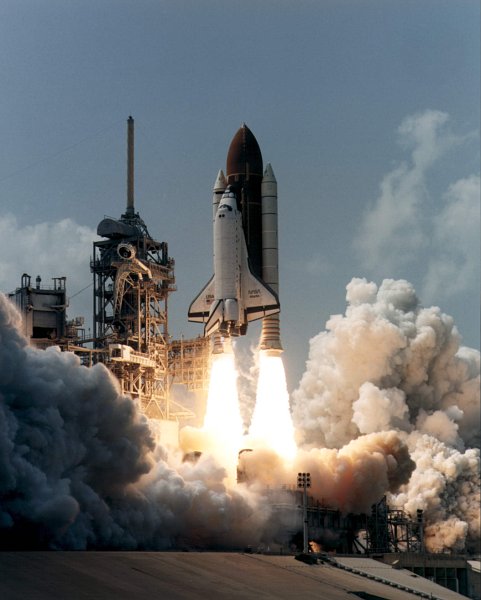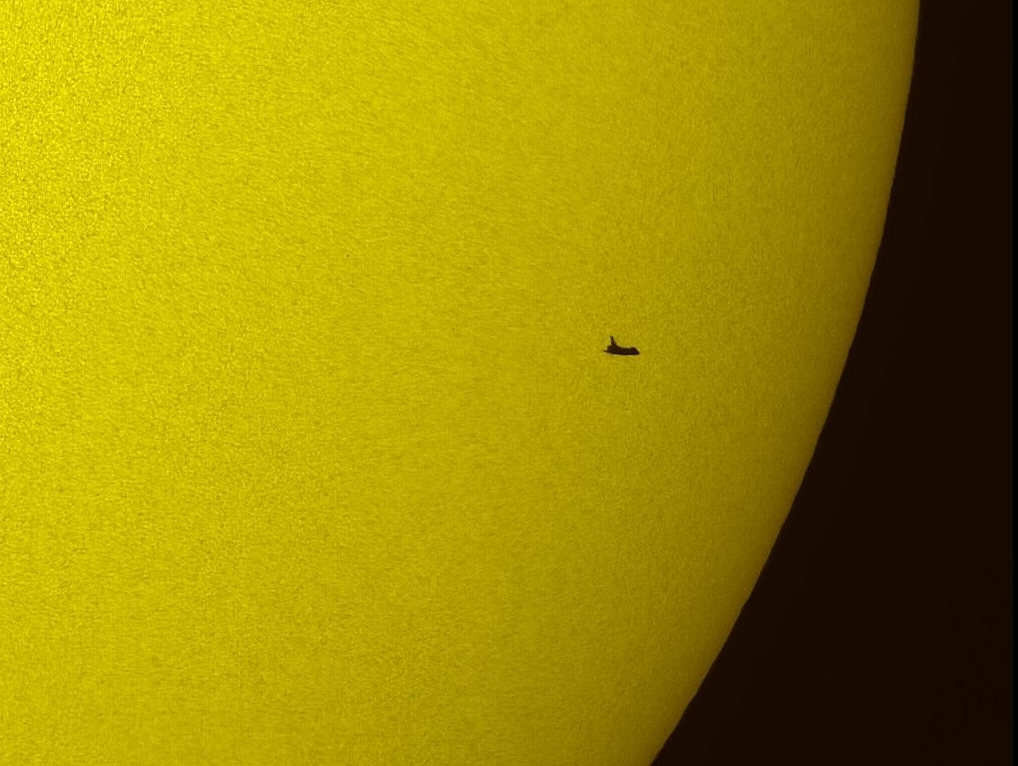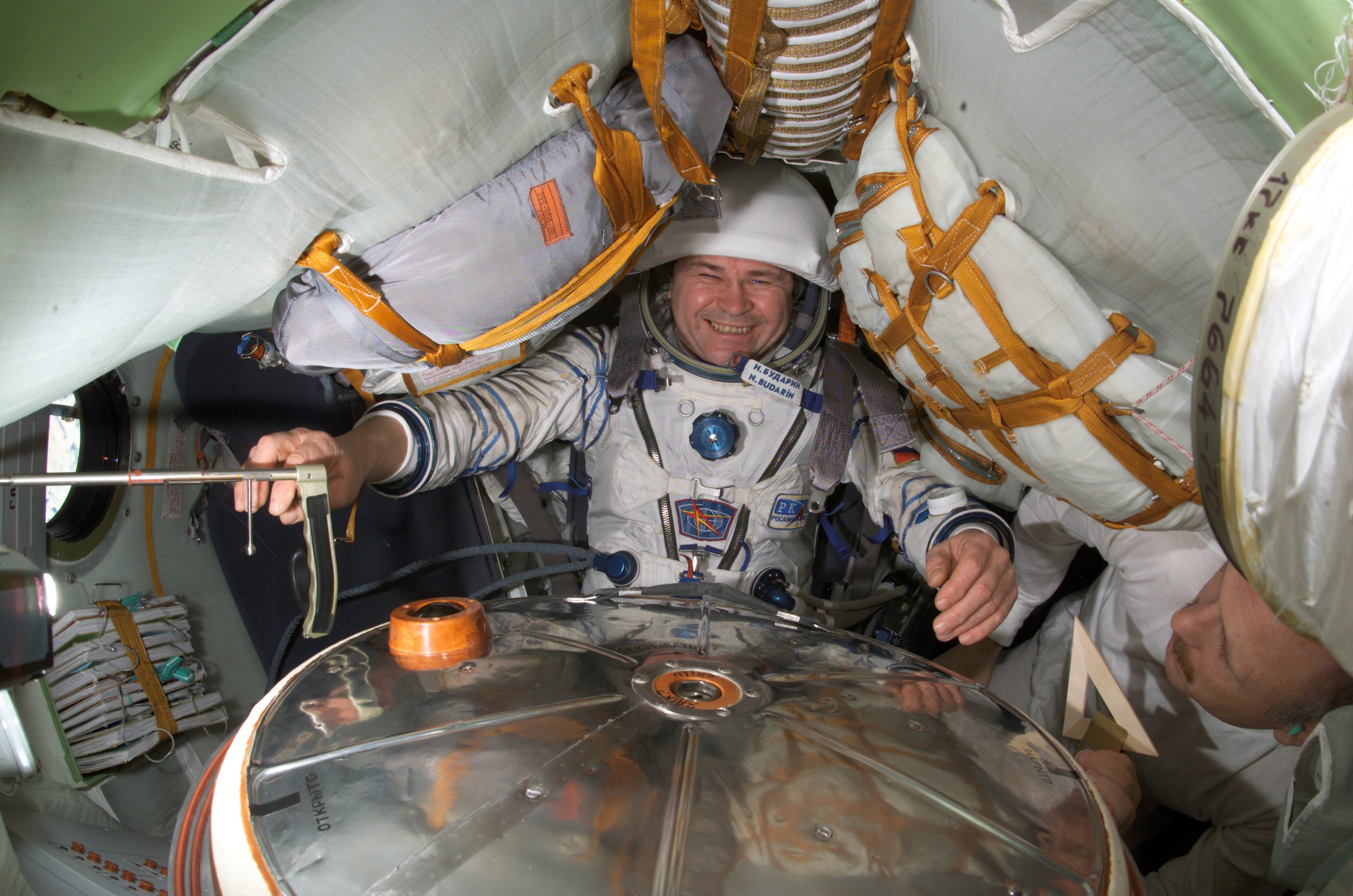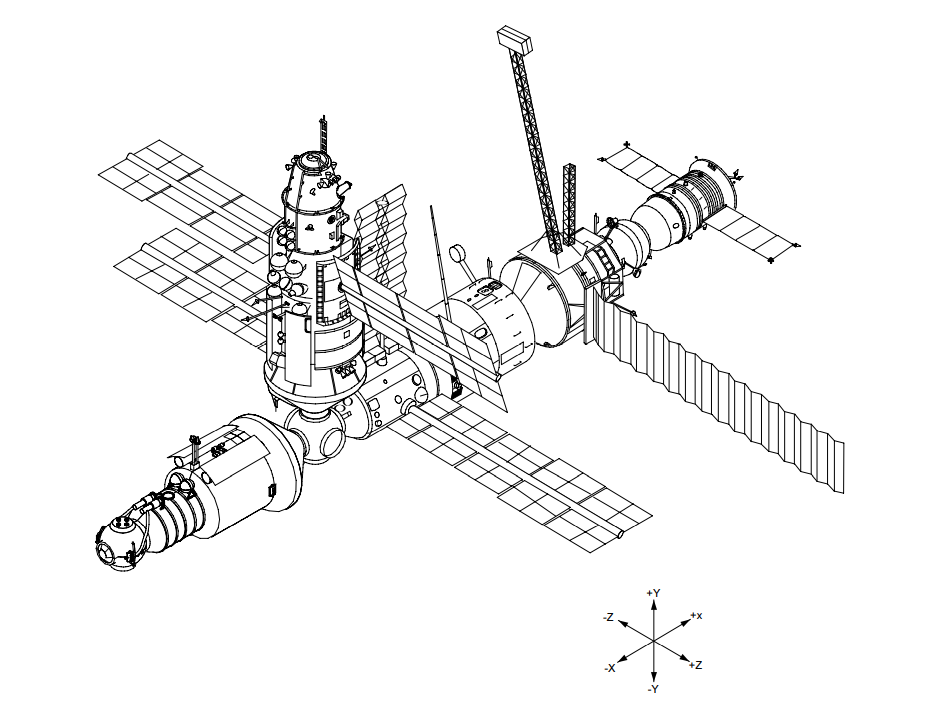|
STS-71
As the third mission of the US/Russian Shuttle-Mir Program, STS-71 became the first Space Shuttle to dock with the Russian space station ''Mir''. STS-71 began on June 27, 1995, with the launch of Space Shuttle ''Atlantis'' from launchpad 39A at the Kennedy Space Center in Florida. The Shuttle delivered a relief crew of two cosmonauts Anatoly Solovyev and Nikolai Budarin to the station and recovered Increment astronaut Norman Thagard. ''Atlantis'' returned to Earth on July 7 with a crew of eight. It was the first of seven straight missions to ''Mir'' flown by ''Atlantis'', and the second Shuttle mission to land with an eight-person crew after STS-61-A in 1985. For the five days the Shuttle was docked to ''Mir'' they were the largest spacecraft in orbit at the time. STS-71 marked the first docking of a Space Shuttle to a space station, the first time a Shuttle crew switched members with the crew of a station, and the 100th crewed space launch by the United States. The mission ... [...More Info...] [...Related Items...] OR: [Wikipedia] [Google] [Baidu] [Amazon] |
Mir EO-19
Mir EO-19 (, also known as Principal Expedition 19) was the nineteenth List of Mir Expeditions, crewed expedition to the space station Mir, lasting from June to September 1995. The crew, consisting of Russian Astronaut, cosmonauts Anatoly Solovyev and Nikolai Budarin, launched on June 27, 1995, aboard the Space Shuttle, Space Shuttle ''Atlantis'' on the STS-71 mission. After remaining aboard Mir for approximately 75 days, Solovyev and Budarin returned aboard the Soyuz TM-21 spacecraft on September 11, 1995. EO-19 lasted just under three months and was the only complete all-Russian crewed expedition to Mir in 1995 and was the first Mir expedition launched on an American Space Shuttle. The mission that launched EO-19, STS-71, was the first Space Shuttle docking to Mir. Crew Antatoly Solovyev served as a crew member on three spaceflights prior to EO-19: Mir EP-2, Soyuz TM-9, and Soyuz TM-15. This flight was his first aboard a Space Shuttle, with his three previous flights bein ... [...More Info...] [...Related Items...] OR: [Wikipedia] [Google] [Baidu] [Amazon] |
Space Shuttle Atlantis
Space Shuttle ''Atlantis'' (Orbiter Vehicle designation: OV‑104) is a retired Space Shuttle orbiter vehicle which belongs to NASA, the spaceflight and space exploration agency of the United States. ''Atlantis'' was manufactured by the Rockwell International company in Southern California and was delivered to the Kennedy Space Center in Eastern Florida in April 1985. ''Atlantis'' is the fourth operational and the second-to-last Space Shuttle built. Its maiden flight was STS-51-J made from October 3 to 7, 1985. ''Atlantis'' embarked on its 33rd and final mission, also the final mission of a space shuttle, STS-135, on July 8, 2011. STS-134 by Space Shuttle Endeavour, ''Endeavour'' was expected to be the final flight before STS-135 was authorized in October 2010. STS-135 took advantage of the processing for the STS-335 Launch on Need mission that would have been necessary if STS-134's crew became stranded in orbit. ''Atlantis'' landed for the final time at the Kennedy Space Cent ... [...More Info...] [...Related Items...] OR: [Wikipedia] [Google] [Baidu] [Amazon] |
Anatoly Solovyev
Anatoly Yakovlevich Solovyev (; ; alternate spelling "Solovyov"; born 16 January 1948) is a retired Latvian and Soviet Union, Soviet cosmonaut and pilot. Solovyev holds the List of cumulative spacewalk records, world record on the number of extra-vehicular activity, spacewalks performed (16) and accumulated time spent spacewalking (over 82 hours). Education Solovyev studied at Riga Secondary School No. 33. After completing secondary school in Riga at age 16, he was a general labourer at a building materials factory, and then a metalworker. He completed two years of evening school and in 1967, enrolled at the Faculty of Physics and Mathematics of the University of Latvia, State University of Latvia. After completing the first year, Anatoly left training to prepare for aviation school while working as a locksmith at the Latvian Joint Aviation Unit. In 1968 Solovyov began his training at the Chernigov Higher Military Aviation School. Military service He enrolled as a cadet in the ... [...More Info...] [...Related Items...] OR: [Wikipedia] [Google] [Baidu] [Amazon] |
STS-70
STS-70 was the 21st flight of the Space Shuttle Space Shuttle Discovery, ''Discovery'', and the last of 7 shuttle missions to carry a Tracking and Data Relay Satellite (TDRS). This was the first shuttle mission controlled from the new mission control center room at the Johnson Space Center in Houston. STS-70 was also the first flight of the new Block 1 orbiter main engine, designed to improve both engine performance and safety. The mission was launched from Kennedy Space Center in Florida on July 13, 1995, only six days after the landing of sister ship ''Atlantis'', marking the fastest turnaround between flights in the history of the program. Crew Crew seat assignments Preparations and launch STS-70 had originally moved ahead of STS-71 because of a delay in the launch of the Russian Spektr laboratory module to the Russian space station Mir. However, on May 31, 1995, shuttle managers assessed damage to the External Tank of STS-70 caused by nesting northern flicker, flicker ... [...More Info...] [...Related Items...] OR: [Wikipedia] [Google] [Baidu] [Amazon] |
Norman Thagard
Norman Earl Thagard (born July 3, 1943; Capt, USMC, Ret.) is an American scientist and former U.S. Marine Corps officer and naval aviator and NASA astronaut. On March 14, 1995, he became the first American to ride to space on board a Russian vehicle, the Soyuz TM-21 spacecraft for the Russian Mir-18 mission. Therefore, Thagard was the first American cosmonaut. Experience Thagard held a number of research and teaching posts while completing the academic requirements for various earned degrees. In September 1966 he entered active duty with the United States Marine Corps Reserve. He achieved the rank of captain in 1967, was designated a Naval Aviator in 1968 and was subsequently assigned to duty flying F-4 Phantom IIs with VMFA-333 at Marine Corps Air Station Beaufort, South Carolina. He flew 163 combat missions in Vietnam while assigned to VMFA-115 from January 1969 to 1970. He returned to the United States and an assignment as aviation weapons division officer with VMFA-251 at ... [...More Info...] [...Related Items...] OR: [Wikipedia] [Google] [Baidu] [Amazon] |
Nikolai Budarin
Nikolai Mikhailovich Budarin () (born 29 April 1953 in Kirya, Russia, Kirya, Chuvashia Republic, Chuvashia) is a retired Russian cosmonaut, a veteran of three extended space missions aboard the Mir Space Station and the International Space Station. He has also performed eight career spacewalks with a total time of 44 hours. Named a cosmonaut candidate in 1989, Budarin's first space mission was a long-term assignment aboard the space station Mir in 1995. Since then, he again made extended stays on Mir in 1998 and the International Space Station Expedition 6 from 2002 to 2003. Personal data Nikolai Budarin is married to Marina Lvovna Budarina (née Sidorenko). They have two sons, Dmitry born in 1977 and Vladislav, born in 1983. His hobbies include fishing, skiing, picking mushrooms, tourism and cycling. His father, Mikhail Romanovich Budarin, died in 1984. His mother, Alexandra Mikhailovna Budarina, died in 1986. Since 2007 he is a member of the Russian parliament, the State Du ... [...More Info...] [...Related Items...] OR: [Wikipedia] [Google] [Baidu] [Amazon] |
Spacelab
Spacelab was a reusable laboratory developed by European Space Agency (ESA) and used on certain spaceflights flown by the Space Shuttle. The laboratory comprised multiple components, including a pressurized module, an unpressurized carrier, and other related hardware housed in the Shuttle's cargo bay. The components were arranged in various configurations to meet the needs of each spaceflight. Spacelab components flew on a total of about 32 Shuttle missions, depending on how such hardware and missions are tabulated. Spacelab allowed scientists to perform experiments in micro-g environment , microgravity in geocentric orbit. There was a variety of Spacelab-associated hardware, so a distinction can be made between the major Spacelab program missions with European scientists running missions in the Spacelab habitable module, missions running other Spacelab hardware experiments, and other Space Transportation System (STS) missions that used some component of Spacelab hardware. Th ... [...More Info...] [...Related Items...] OR: [Wikipedia] [Google] [Baidu] [Amazon] |
Soyuz TM-21
Soyuz TM-21 was a crewed Soyuz (spacecraft), Soyuz spaceflight to ''Mir''. The mission launched from Baikonur Cosmodrome, atop a Soyuz-U2 carrier rocket, at 06:11:34 UTC on 14 March 1995. The flight marked the first time thirteen humans were flying in space simultaneously, with three aboard the Soyuz, three aboard ''Mir'' and seven aboard Space Shuttle Endeavour, Space Shuttle ''Endeavour'', flying STS-67. The spacecraft carried expedition EO-18 to the space station. This included the first American astronaut to launch on a Soyuz spacecraft and board ''Mir'', Norman Thagard, for the American Thagard Increment aboard the station, which was the first Shuttle-Mir Program#Increments, Increment of the Shuttle-Mir program. The three crew members it launched were relieved by Space Shuttle Atlantis, Space Shuttle ''Atlantis'' during STS-71, when they were replaced by expedition EO-19. The crew returned to earth aboard Soyuz TM-21 on 11 September 1995. Crew Mir Principal ... [...More Info...] [...Related Items...] OR: [Wikipedia] [Google] [Baidu] [Amazon] |
Vladimir Dezhurov
Vladimir Nikolayevich Dezhurov (; born July 30, 1962) is a Russian former cosmonaut who resides in Star City, Moscow. He is a veteran of two spaceflights, to the Mir and International Space Stations. During his career, Dezhurov also conducted nine spacewalks before his retirement on July 12, 2004. Personal Dezhurov was born on July 30, 1962, in the settlement of Yavas, Zubovo-Polyansky District, Mordovia, Russia. He is married to Elena Valentinovna Dezhurova (née Suprina). They have two daughters, Anna, born in 1983, and Svetlana, born in 1987. His father, Nikolai Serafimovich Dezhurov and mother, Anna Vasilevna Dezhurova reside in Yavas settlement, Zubovo-Polyansk district, Mordovia, Russia. Education Dezhurov attended and graduated from the S.I. Gritsevits Kharkov Higher Military Aviation School in 1983 with a pilot engineer's diploma. Experience After graduating, Dezhurov served as a pilot and senior pilot in the Russian Air Force. Awards Dezhurov was awarded the He ... [...More Info...] [...Related Items...] OR: [Wikipedia] [Google] [Baidu] [Amazon] |
Gennady Strekalov
Gennady Mikhailovich Strekalov (; 26 October 1940 – 25 December 2004) was an engineer, cosmonaut, and administrator at Russian aerospace firm RSC Energia. He flew into space five times and lived aboard the Salyut 6, Salyut 7, and Mir space stations, spending over 268 days in space. The catastrophic explosion of a Soyuz rocket in 1983 led to him being one of only four people to use a launch escape system. He was decorated twice as Hero of the Soviet Union and received the Ashoka Chakra from India. Personal life Strekalov was born on 26 October 1940 in Mytishchi near Moscow, the son of Mikhail Strekalov and his wife Praskoyva. Mikhail Strekalov was killed in 1945 while fighting for the Red Army in Poland. Gennadi Strekalov graduated from N. E. Bauman Moscow Higher Technical School in 1965 with an engineer's diploma. He married Lydia Anatolievna Telezhina; the couple had two daughters, Tatiana and Natalia. He died in Moscow on 25 December 2004, from cancer, aged 64. Career ... [...More Info...] [...Related Items...] OR: [Wikipedia] [Google] [Baidu] [Amazon] |
Kristall
The Kristall () (77KST, TsM-T, 11F77T) module was the fourth module and the third major addition to ''Mir''. As with previous modules, its configuration was based on the 77K (TKS) module, and was originally named "Kvant 3". It was launched on May 31, 1990 on Proton-K. It docked to Mir autonomously on June 10, 1990. Description Kristall had several materials processing furnaces. They were called Krater 5, Optizon 1, Zona 2, and Zona 3. It also had a biotechnology experiment called the Aniur electrophoresis unit. These experiments were capable of generating 100 kg of raw materials for use on Earth. Located in the docking node was the Priroda 5 camera which was used for Earth resources experiments. Kristall also had several astronomy and astrophysics experiments which were designed to augment experiments that were already located in Kvant-1. Kristall's solar panels were also different from others on Mir. They were designed to be "collapsible" which means that they could be de ... [...More Info...] [...Related Items...] OR: [Wikipedia] [Google] [Baidu] [Amazon] |
Space Shuttle
The Space Shuttle is a retired, partially reusable launch system, reusable low Earth orbital spacecraft system operated from 1981 to 2011 by the U.S. National Aeronautics and Space Administration (NASA) as part of the Space Shuttle program. Its official program name was the Space Transportation System (STS), taken from the 1969 plan led by U.S. vice president Spiro Agnew for a system of reusable spacecraft where it was the only item funded for development. The first (STS-1) of four orbital test flights occurred in 1981, leading to operational flights (STS-5) beginning in 1982. Five complete Space Shuttle orbiter vehicles were built and flown on a total of 135 missions from 1981 to 2011. They launched from the Kennedy Space Center (KSC) in Florida. Operational missions launched numerous satellites, interplanetary probes, and the Hubble Space Telescope (HST), conducted science experiments in orbit, participated in the Shuttle–Mir program, Shuttle-''Mir'' program with Russia, ... [...More Info...] [...Related Items...] OR: [Wikipedia] [Google] [Baidu] [Amazon] |








